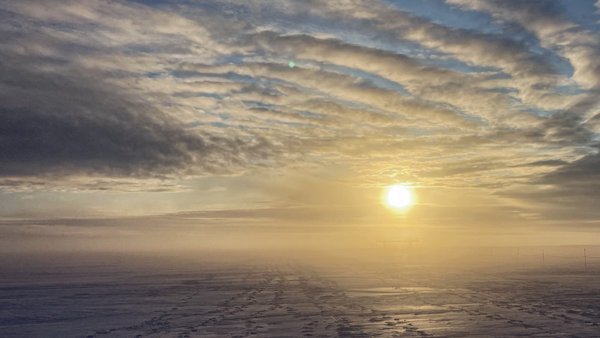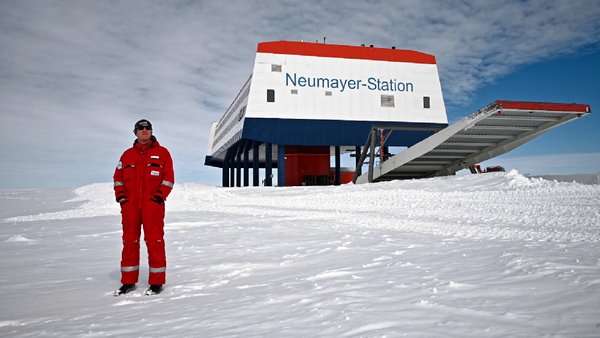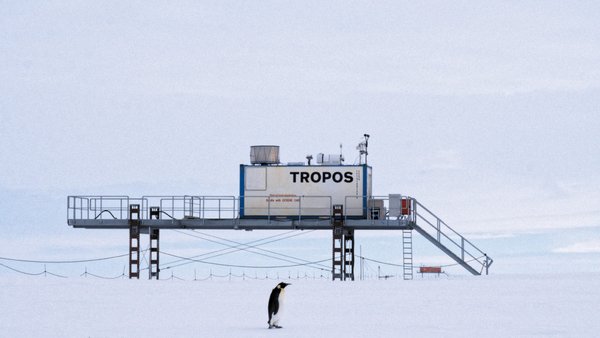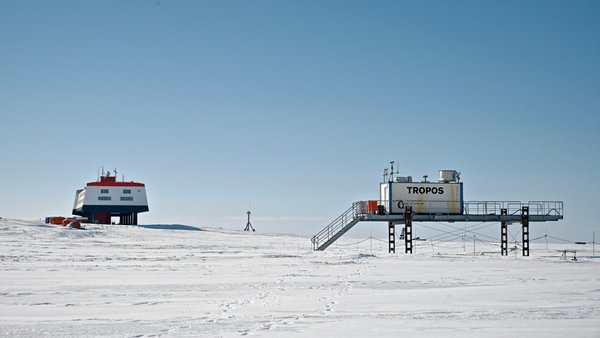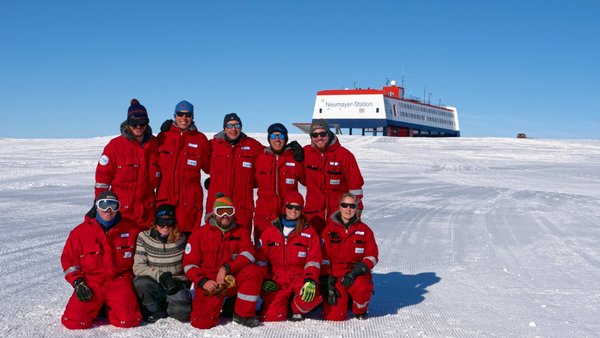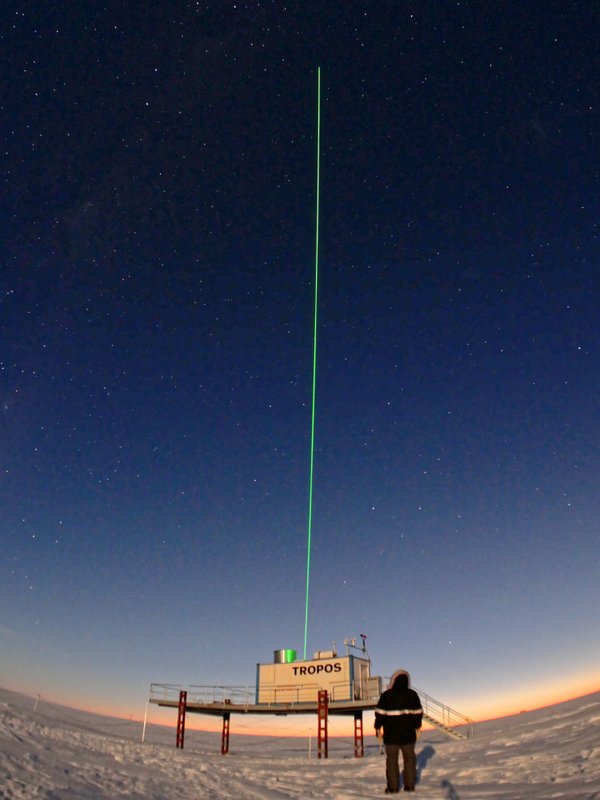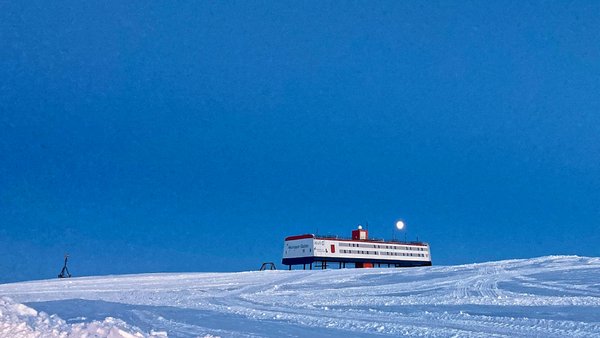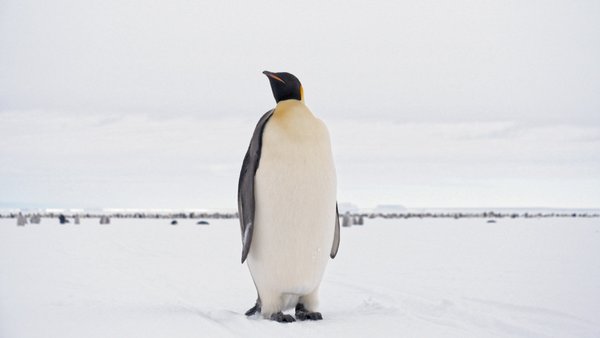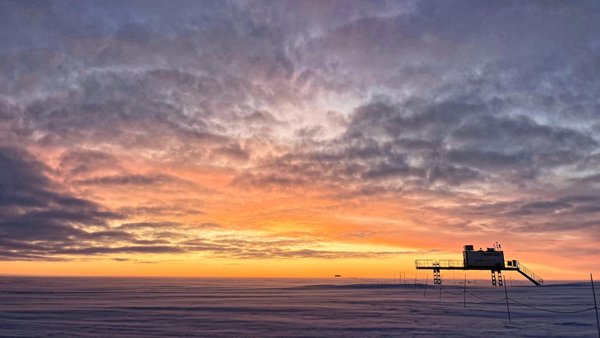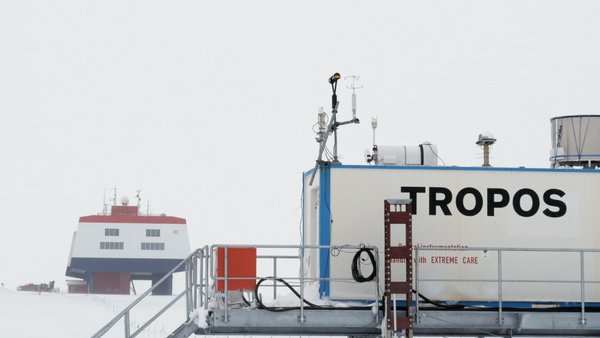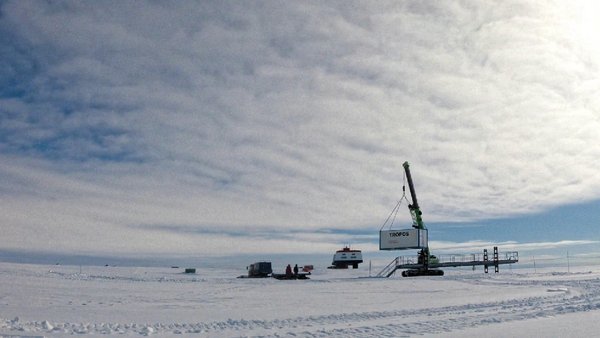Exceptional warm air intrusions and omnipresent aerosol layers in the stratosphere.
Leipzig,
13.09.2024
First results of one year of cloud research at the German polar station Neumayer III published.
Leipzig/Bremerhaven. Extremely clean air on the ground, warm air intrusions and sulphate aerosol at high altitudes - a Leipzig research project has gained new insights into clouds in Antarctica. From January to December 2023, the vertical distribution of aerosol particles and clouds in the atmosphere above the German Neumayer Station III of the Alfred Wegener Institute, Helmholtz Centre for Polar and Marine Research (AWI) was investigated from the ground for the first time. The height-resolved measurements were the first of their kind in Queen Maud Land, the area of the Antarctic that borders the Atlantic and covers an area larger than Greenland.
The observations were performed with the OCEANET-Atmosphere platform from the Leibniz Institute for Tropospheric Research (TROPOS). OCEANET-Atmosphere demonstrated its robustness already while it was drifting in the Arctic for a whole year on the RV Polarstern during the international MOSAiC expedition 2019/20. During the 12 months of operation in Antarctica, the platform was supervised on-site by TROPOS scientist Martin Radenz. Initial results have now been published in the renowned journal Bulletin of the American Meteorological Society (BAMS). The measurements were funded by the German Research Foundation (DFG) and carried out in close co-operation with the AWI.
The Antarctic continent and the Southern Ocean are important components of the global climate system. While Antarctica's climate was considered relatively stable in the last century, significant changes are now being observed. Climate projections indicate that the interior of the Antarctic will warm by more than 3 Kelvin, the sea ice extent will decrease by around 30 per cent and precipitation will increase in the 21st century. However, such projections are subject to major uncertainties and the global atmospheric circulation models are not yet able to correctly reproduce the cloud cover and radiative forcing over the Southern Ocean. This incorrect representation of clouds leads to distorted estimates of thermal radiation and sea surface temperature, which are a prerequisite for estimating the energy fluxes between the ocean and atmosphere. In addition, in order to be able to document any change in an environment, such as Antarctica, also its current state needs to be documented as good as possible.
Gaining knowledge about cloud formation in Antarctica is an essential need, as this takes place differently in the clean air of the southern hemisphere than in the northern hemisphere with more abundant land surfaces. A second major source of uncertainty is the transport of moisture and particles from the mid-latitudes and subtropics to the pole. The relatively flat surface between the Weddell Sea and the South Pole might be a kind of highway for warm and humid air masses.
In order to learn more about the clouds in Antarctica, the instrumentation at the German research station Neumayer III of the AWI were supplemented by remote-sensing measurements such as an atmospheric lidar and a cloud radar for around a full year in the framework of the project COALA (Continuous Observations of Aerosol-Cloud Interactions in the Antarctic). The importance of the project was well recognized by the priority program ‘Antarctic Research’ of the German Science Foundation (Deutsche Forschungsgemeinschaft, DFG), which provided the funding for the endeavour. Carrier of the instrumentation was the TROPOS OCEANET-Atmosphere container. The platform had previously drifted through the Arctic for a year on RV Polarstern during the MOSAiC expedition led by AWI in 2019/20. " The MOSAiC observations allowed us to show for the first time that the atmosphere at the North Pole is more polluted than previously assumed. But what about over the Antarctic? Fortunately, we had the opportunity to operate our OCEANET container there for a year," explains Dr Ronny Engelmann from TROPOS. OCEANET was installed 300 meters south of the German Antarctic Neumayer Station III at the beginning of 2023. OCEANET-Atmosphere is an autonomous, polar-tested, specially equipped 20-foot container packed with state-of-the-art atmospheric observation equipment. It is currently the only polar-capable single container platform that combines multiwavelength lidar, a cloud radar, a microwave radiometer, and a Doppler lidar to observe clouds and aerosols, including turbulent air motions.
OCEANET was supplied with power from the research station, where the researcher from Leipzig also lived and spent a year making sure that all the devices measured without interruption: Dr Martin Radenz from TROPOS joined the station's core team. He was one of the 10 people who spent the winter in the dark polar night at Neumayer Station III. "Being able to spend a year in Antarctica with the community of our small team, the fascinating nature, snowstorms and isolation was a unique experience," reports Martin Radenz. The green laser beam of the multiwavelength lidar, which scanned the atmosphere above Neumayer Station III, was a novelty in this part of Antarctica. A lidar, also known as a "light radar", sends short laser pulses from the ground into the atmosphere and receives the backscattered light with a special receiver. Information about the height, quantity and type of suspended particles (aerosols) in the atmosphere can be derived from the travel time, intensity and polarisation of the backscattered signals. To date, related measurements with cloud radar and aerosol lidar have only been carried out at McMurdo station on the other side of Antarctica, 3500 kilometres away, bordering the Pacific Ocean. Contrary to Neumayer III on the ice shelf, the US McMurdo station there is built on rock. The researchers also hope that the measurements taken at Neumayer Station III over ice shelves will provide them with new insights into cloud formation over the vast expanses of ice in the Antarctic. "It is particularly pleasing that, following COALA, the AWI now permanently deploys similar remote sensing devices at Neumayer Station III in cooperation with TROPOS. This will make an important contribution to recording the short-lived climate components aerosols and clouds in the Antarctic," says Prof Andreas Macke, Director of TROPOS and Head of the "Remote Sensing of Atmospheric Processes" department.
In January 2024, the OCEANET container was dismantled, transported to the edge of the ice shelf and loaded onto the resupply vessel. The devices arrived in Leipzig in March, the DFG COALA project was completed and the researchers took stock: "All the devices held out and recorded valuable data. We are particularly pleased about this because it would have taken months for a replacement part to arrive during the polar night. Our experience from the MOSAiC expedition three years earlier in the Arctic was a great help. Nevertheless, it was a real challenge to make the devices storm-proof and clean them of snow almost every day," reports Martin Radenz. For Radenz and his team, however, the effort was worth it. The measurements provided three new insights into the Antarctic under climate change:
Atmosphere only clean close to the surface
The lidar measurements provided an insight into how many particles are floating above this part of Antarctica and at which altitudes. The lower part of the atmosphere (troposphere) with pristine conditions was mostly comparatively clean. In contrast, the team observed an unexpectedly large number of particles between an altitude of around 9 km and 17 km (stratosphere). "The optical properties of the aerosol derived from the lidar clearly indicate sulphate aerosol, which is mainly caused by volcanic eruptions. These aerosols were observed in the stratosphere since January 2023 and are therefore most likely related to the eruption of Hunga Tonga-Hunga Ha'apai in January 2022," says Martin Radenz. "The fact that volcanic dust can persist for a very long time over the south polar region surprised us just as much as the forest fire smoke over the north polar region, which we were able to observe for the first time during the MOSAiC expedition in 2020," reports Ronny Engelmann. The lidar measurements from the ground are particularly important, as the volcanic aerosol over Antarctica has apparently not been observed sufficiently from space before. At least no aerosol was detectable in the standard products of NASA's CALIOP satellite lidar. Aerosol in the stratosphere has an influence on the occurrence of polar stratospheric clouds (PSCs), where complex chemical processes take place and which are suspected of contributing to the hole in the ozone layer over the polar regions.
Aerosol-cloud interaction in shallow mixed-phase clouds
While more aerosol was observed in the upper layers of the atmosphere than expected, the lower layers proved to be about as clean as assumed. The continuous measurements enabled the team to "watch" the clouds grow. For example, a stable mixed-phase cloud consisting of ice crystals and water droplets embedded in a layer of marine aerosol was observed for a period of 10 hours. "Our measurements confirm that practically all particles serve as cloud nuclei, to either form cloud droplets or ice crystals. Cloud growth is therefore limited by the amount of particles. If there were more particles, for example because more polluted air flows into the Antarctic, then there would also be more droplets and ice crystals in the clouds, which would change their lifespan and lead to yet unknown effects on weather and climate," explains Dr Patric Seifert from TROPOS.
Unusual warm air intrusions
Warm air from lower latitudes could intensify climate change in Antarctica. It was therefore important to be able to analyse two extreme warm air intrusions in detail: One with intense snowfall in April, which brought 10 per cent of the snowfall of an entire year, and a second with record-breaking maximum temperatures and heavy ground icing due to supercooled drizzle in July. During this warm spell, the temperature rose to -2.3 degrees Celsius on 6 July 2023. "This is the highest temperature recorded in July at the German Antarctic Neumayer Station since continuous observations began in 1982. This means that it has never been so warm there in the middle of the polar night, the peak of the Antarctic winter," explains Martin Radenz. These unusually high temperatures led to supercooled drizzle. On the surface, a layer of clear ice of around 2 millimetres formed on top of the snow from the previous day. "What often happens here in Central Europe in winter is very unusual for the Antarctic during the dark polar night. Normally, temperatures at Neumayer Station III are below -30 degrees Celsius in July. Our observations over ice shelves are the first of their kind," emphasizes Radenz.
It took not long until the value of the remote sensing measurements was also recognized by the Alfred Wegener Institute that operates the Neumayer station. The deployment of OCEANET-Atmosphere was only the start of a long-term time series of profile measurements in this part of Antarctica: at the beginning of 2024, the Alfred Wegener Institute expanded the permanent observation capacities with a lidar and radar, thus ensuring that the unique OCEANET data set is continued. “The long-term climatology of aerosol and cloud parameters for the Neumayer station will thus be permanently extended to the vertical dimension," explains Dr Holger Schmithüsen from AWI.
The provision of an overview of the obtained results in the BAMS journal demonstrates the potential of the 1-year dataset for shedding light on the still barely characterized properties of clouds and aerosols above Antarctica. “But the BAMS article only provides a first glimpse into the highlights obtained during the measurements. Detailed statistics and process studies will follow in a subsequent step,” says Radenz. Over the next few months, the extensive data from Antarctica will be further analysed and compared with existing data sets from southern Chile, Cyprus, Germany and the Arctic. The researchers hope to gain new insights into why the clouds in the far south differ so much from those in the northern hemisphere. Plenty of datasets from key-regions of climate research are available for a comparison. As part of the DFG Transregio "Arctic Amplification" (AC3-TR), TROPOS has been investigating clouds in the Arctic together with the University of Leipzig since 2016. In addition, processes in the southern hemisphere have also become the focus of attention in recent years: in 2016/17, cloud researchers from Leipzig took part in the international Antarctic circumnavigation ACE. In 2018-2021, extensive measurements took place in southern Chile. Two major measurement campaigns in and around New Zealand are currently being prepared for 2025 and 2026: goSouth at the southern tip of the South Island, accompanied by HALO-South with the German research aircraft HALO and an expedition around New Zealand with the research vessel Sonne are the placemarks of the next series of experiments under the lead of TROPOS. "TROPOS is about to contribute important novel insights for improving the understanding of aerosol-cloud-climate processes in the clean and maritime southern hemisphere," concludes Prof Andreas Macke.
Tilo Arnhold
Publication:
Radenz, M., and Coauthors, 2024: Ground-based Remote Sensing of Aerosol, Clouds, Dynamics, and Precipitation in Antarctica -First results from the one-year COALA campaign at Neumayer Station III in 2023. Bull. Amer. Meteor. Soc., 105, E1438–E1457, https://doi.org/10.1175/BAMS-D-22-0285.1
< online since 9 August 2024 >
The research was funded by Deutsche Forschungsgemeinschaft (DFG; Funding 463307613 & priority program 1158 “Antarctic Research with Comparative Investigations in Arctic Ice Areas” (Funding HE 6770/3-1)), NERC National Capability International Grant Surface Fluxes in Antarctica (SURFEIT) (NE/X009319/1), the European Union’s Horizon 2020 research and innovation programme (Grant Agreement 101003826 via project Climate Relevant interactions and feedbacks: the key role of sea ice and Snow in the polar and global climate system (CRiceS)). OCEANET-Atmosphere is part of ACTRIS-D, which is funded by the Federal Ministry of Education and Research of Germany (BMBF) under the FONA Strategy “Research for Sustainability” (funding code 01LK2001A). BMBF also funded hardware components under the funding code 01LK1603A. This research has been supported by ACTRIS-IMP through Horizon 2020 Research Infrastructures (Grant 871115).
Contacts for the media:
Dr Martin Radenz
Research Associate, Department of Remote Sensing of Atmospheric Processes, Leibniz Institute for Tropospheric Research (TROPOS), Leipzig
Phone +49 341 2717-7369
https://www.tropos.de/institut/ueber-uns/mitarbeitende/martin-radenz
and
Dr Ronny Engelmann / Dr Patric Seifert
Research Associate, Department of Remote Sensing of Atmospheric Processes, Leibniz Institute for Tropospheric Research (TROPOS), Leipzig
Phone: +49 341 2717-7315, -7080
https://www.tropos.de/institut/ueber-uns/mitarbeitende/ronny-engelmann
https://www.tropos.de/institut/ueber-uns/mitarbeitende/patric-seifert
and
Prof Dr Andreas Macke
Director and Head of Department, Department of Remote Sensing of Atmospheric Processes, Leibniz Institute for Tropospheric Research (TROPOS), Leipzig
Phone +49 341 2717-7060
https://www.tropos.de/institut/ueber-uns/mitarbeitende/andreas-macke
and
Dr Holger Schmithüsen
Scientific Coordinator Meteorological Observatories Neumayer and Polarstern
Alfred Wegener Institute, Helmholtz Centre for Polar and Marine Research (AWI), Bremerhaven
Phone: +49-471-4831-1806
https://www.awi.de/ueber-uns/organisation/mitarbeiter/detailseite/holger-schmithuesen.html
or
Tilo Arnhold, TROPOS Public Relations
Phone +49 341 2717-7189
http://www.tropos.de/aktuelles/pressemitteilungen/
and
Sarah Werner, AWI Press Office
Phone +49 471 4831-2008
https://www.awi.de/ueber-uns/organisation/kommunikation-und-medien.html
Note for the media:
High-resolution photos are available free of charge for media use, provided the source is quoted:
https://owncloud.gwdg.de/index.php/s/cXcgAe3uaym6Ebc
Further information and links:
Lidar data from the Antarctic:
Polly Arielle @ AWI antarctic station Neumayer III
https://polly-tmp.tropos.de/calendar/location/49
Blog:
COALA 2022 - 2023
https://www.tropos.de/aktuelles/messkampagnen/blogs-und-berichte/coala-2022-2023
The mystery of the green laser beam (Antarctic blog: AtkaXpress, 13 October 2023)
https://blogs.helmholtz.de/atkaxpress/2023/10/das-raetsel-um-den-gruenen-laserstrahl/
TROPOS press releases on Antarctica & Arctic:
New cloud research project launched at the German Antarctic station Neumayer-III (21/02/2023)
https://www.tropos.de/aktuelles/pressemitteilungen/details/neues-projekt-zur-wolkenforschung-an-der-deutschen-antarktisstation-neumayer-iii-gestartet
German researchers in New Zealand on the trail of climate change (18.11.2022)
https://www.tropos.de/aktuelles/pressemitteilungen/details/deutsche-forschende-in-neuseeland-auf-den-spuren-der-klimaveraenderung
Updrafts are crucial - Clouds in the southern hemisphere better understood (26.01.2022)
https://www.tropos.de/aktuelles/pressemitteilungen/details/aufwinde-entscheidend-wolken-in-der-suedhemisphaere-genauer-verstanden
Climate change and forest fires could increase ozone hole (21.01.2022)
https://www.tropos.de/aktuelles/pressemitteilungen/details/klimawandel-und-waldbraende-koennten-ozonloch-vergroessern
Unique view of the "new Arctic": International MOSAiC expedition successfully completed (12.10.2020)
https://www.tropos.de/aktuelles/pressemitteilungen/details/einmaliger-blick-in-die-neue-arktis-internationale-mosaic-expedition-erfolgreich-beendet
Around the South Pole in 90 days (16.12.2016)
https://www.tropos.de/aktuelles/pressemitteilungen/details/in-90-tagen-um-den-suedpol
Neumayer Station III in the Antarctic
Neumayer Station III
https://www.awi.de/expedition/stationen/neumayer-station-iii.html
Neumayer Station III - The Meteorological Observatory
https://www.awi.de/forschung/langzeitbeobachtung/atmosphaere/antarktis-neumayer/meteorologie.html
Neumayer Station III - The Trace Substance Observatory ("Spuso")
https://www.awi.de/forschung/langzeitbeobachtung/atmosphaere/antarktis-neumayer/luftchemie.html
Antarctica Blog: AtkaXpress
https://blogs.helmholtz.de/atkaxpress/
Promotion:
DFG project COALA (Continuous Observations of Aerosol-Cloud Interaction in the Antarctic)
https://gepris.dfg.de/gepris/projekt/463307613
DFG project VACCINE+ (Variation of Antarctic cloud condensation nuclei (CCN) and ice nuclei (INP) concentrations and properties at Neumayer III in comparison to their values in the Arctic at the Villum research station (VACCINE+))
https://gepris.dfg.de/gepris/projekt/442925270?language=de
The Leibniz Institute for Tropospheric Research (TROPOS) is a member of the Leibniz Association, which unites 96 independent research institutions. Their focus ranges from the natural, engineering and environmental sciences to economics, spatial and social sciences and the humanities. Leibniz Institutes are dedicated to socially, economically and ecologically relevant issues.
They conduct knowledge- and application-oriented research, including in the overarching Leibniz Research Alliances, are or maintain scientific infrastructures and offer research-based services. The Leibniz Association focuses on knowledge transfer, especially with the Leibniz Research Museums. It advises and informs politics, science, business and the public.
Leibniz institutions maintain close cooperation with universities - including in the form of the Leibniz ScienceCampi, with industry and other partners in Germany and abroad. They are subject to a transparent and independent review process. Due to their national importance, the federal and state governments jointly fund the institutes of the Leibniz Association. The Leibniz Institutes employ around 20,500 people, including 11,500 scientists.
The total budget of the institutes is 2 billion euros. They are jointly financed by the federal and state governments. The basic funding of the Leibniz Institute for Tropospheric Research (TROPOS) is provided by the Federal Ministry of Education and Research (BMBF) and the Saxon State Ministry of Science and the Arts (SMWK). The institute is co-financed by tax revenue on the basis of the budget approved by the Saxon State Parliament.
http://www.leibniz-gemeinschaft.de
https://www.bmbf.de/
https://www.smwk.sachsen.de/
